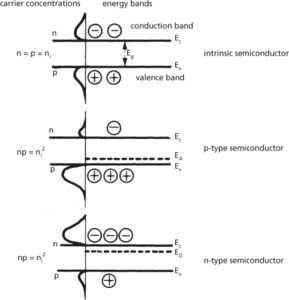The number of charge carriers in a semiconductor per unit volume, in practice usually quoted as numbers per cubic centimetre. In an intrinsic (i-type) semiconductor the number of holes, p, and of electrons, n, is equal to the intrinsic density, ni:
where
where Nc and Nv are the effective densities of energy states in the conduction and valence bands respectively, Eg is the difference in energy between the conduction and valence bands, k is the Boltzmann constant, and T the thermodynamic temperature.
In an extrinsic semiconductor the electrical neutrality of the sample is preserved and in a sample that contains impurities,
where NA− and ND+ are the numbers of ionized acceptor and donor impurities, respectively. At relatively high temperatures most of the impurity atoms are ionized and it is possible to state that
where NA and ND are the total numbers of acceptors and donors. The product np = ni2 is independent of added impurities.
In an n-type semiconductor the number of electrons, nn, at thermal equilibrium is given by
provided ND > NA >> ni

Carrier concentrations in semiconductors
The number of holes, pn, in an n-type semiconductor is given by
In a p-type semiconductor the situation is reversed:
provided NA >; ND >> ni
The number of electrons is given by
The carrier concentrations of i-, n-, and p-type semiconductors are shown schematically in the diagram, where EA and ED are the locations of the energy levels of the acceptor and donor impurities respectively.
- probability distribution
- probability distribution((of a random variable))
- probability distributions
- probability function
- probability generating function
- probability-generating function
- probability laws
- probability mass function
- probability measure
- probability((of a random event))
- probability paper
- probability, philosophy of
- probability space
- probability vector
- probable error
- probable error(in statistics)
- PROBA-V
- probe
- probe message
- probit
- probit analysis
- probit link
- probit model
- problematic
- problem definition